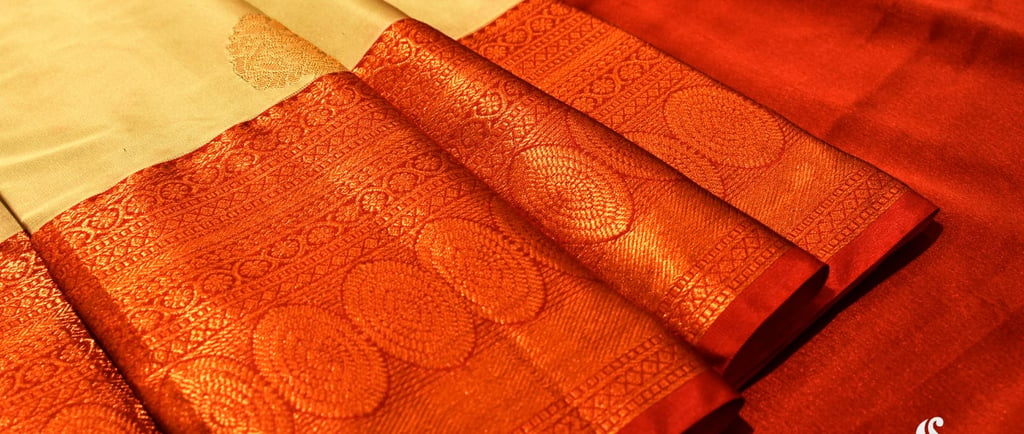Exclusive discounts on exquisite silk sarees!
The Ultimate Guide to Spotting Real Kanchipuram Sarees: Weave Secrets & Certification Tips
The timeless allure of a Kanchipuram saree stems not just from its exquisite craftsmanship, but from the centuries-old heritage it embodies. Yet, as imitations flood the market, distinguishing an authentic piece has become more crucial than ever. In this guide, we unravel the most frequently asked questions about verifying genuine Kanchipuram silk sarees and share expert tips to help you make a confident, informed purchase.
Sree Vijayalakshmi Silks
6/30/20255 min read


What Is a Kanchipuram Saree?
A Kanchipuram saree (also known as Kanjivaram saree) is a traditional silk saree originating from the temple town of Kanchipuram in Tamil Nadu. Renowned for its opulence and craftsmanship, it is woven from pure mulberry silk and adorned with zari—silver threads dipped in gold—giving it a rich luster and exceptional durability.
Key Characteristics:
Handloom Craftsmanship: Each saree is meticulously woven by skilled artisans using age-old handloom techniques passed down through generations.
Distinctive Motifs: Bold and symbolic patterns such as temple borders, checks, stripes, and floral designs are signature elements.
Contrasting Borders: The border and body are often woven separately and then interlocked with precision, creating a striking contrast that enhances the saree’s grandeur.
A true Kanchipuram saree is not just attire—it's a legacy woven in silk.
How Can I Identify a Genuine Kanchipuram Saree?
Spotting an authentic Kanchipuram saree requires a keen eye for detail and an appreciation for traditional craftsmanship. Here are the hallmark features to look for:
Korvai Join (Pallu and Border): One of the most distinctive traits is the korvai weaving technique, where the pallu and border are woven separately and then interlocked with the body. Look closely for a subtle zig-zag pattern at the joining point—this is a signature of authenticity.
Weight and Texture: Genuine Kanchipuram sarees are crafted from pure mulberry silk and real zari, giving them a noticeably heavier and more luxurious feel compared to synthetic imitations.
Intricate Motifs: Traditional designs such as peacocks, chakras, temple towers, and mango motifs are intricately hand-woven—not printed. The detailing is sharp, symmetrical, and rich in cultural symbolism.
Zari Thread Test: Authentic zari is made by wrapping silk threads in silver and then dipping them in gold. Gently rub the zari—if you see red silk threads underneath, it’s a sign of genuine craftsmanship.
By paying attention to these details, you can ensure that your Kanchipuram saree is not just beautiful, but truly authentic.
What Is Silk Mark Certification?
The Silk Mark is the official seal of authenticity for pure silk, issued by the Silk Mark Organisation of India (SMOI), a body under the Ministry of Textiles, Government of India. This certification guarantees that the product is made from 100% natural silk, ensuring both quality and purity.
How to Identify a Silk Mark Certified Saree:
Look for the Silk Mark tag—typically attached near the pallu of the saree.
Check for a QR code or hologram—many certified sarees include these features for added verification.
Is All Kanjivaram Silk Pure Silk?
Not always. While Kanjivaram (or Kanchipuram) sarees are renowned for their luxurious feel and craftsmanship, not every saree sold under this name is made from pure silk. Many sellers offer blended fabrics or art silk sarees that mimic the look of authentic Kanjivaram but lack the quality.
What makes a saree truly Kanjivaram?
Genuine Kanjivaram sarees are woven from three-ply mulberry silk and feature real zari—threads made from silver and gold. In contrast, imitations often use polyester or mixed silk and synthetic zari, which compromises both durability and elegance.
How to spot the real deal:
Buy from reputed handloom stores – Trusted sellers are more likely to offer authentic weaves.
Ask for a bill and silk mark certification – This ensures transparency and authenticity.
Inspect the weave under light – Pure silk has a soft, natural sheen, while synthetic fabrics tend to have a harsh, overly shiny appearance.
Investing in a real Kanjivaram saree means embracing a piece of heritage. A little vigilance goes a long way in preserving its legacy
Why It Matters:
Always choose Kanchipuram sarees with Silk Mark certification to ensure you're investing in genuine, high-quality silk. It’s your assurance of tradition, craftsmanship, and authenticity.
Is All Kanjivaram Silk Pure Silk?
Not always. While Kanjivaram (or Kanchipuram) sarees are renowned for their luxurious feel and craftsmanship, not every saree sold under this name is made from pure silk. Many sellers offer blended fabrics or art silk sarees that mimic the look of authentic Kanjivaram but lack the quality.
What makes a saree truly Kanjivaram?
Genuine Kanjivaram sarees are woven from three-ply mulberry silk and feature real zari—threads made from silver and gold. In contrast, imitations often use polyester or mixed silk and synthetic zari, which compromises both durability and elegance.
How to spot the real deal:
Buy from reputed handloom stores – Trusted sellers are more likely to offer authentic weaves.
Ask for a bill and silk mark certification – This ensures transparency and authenticity.
Inspect the weave under light – Pure silk has a soft, natural sheen, while synthetic fabrics tend to have a harsh, overly shiny appearance.
Investing in a real Kanjivaram saree means embracing a piece of heritage. A little vigilance goes a long way in preserving its legacy.
Where to Buy Authentic Kanchipuram Sarees in Bangalore?
Bangalore is home to a number of renowned silk showrooms that cater to connoisseurs of traditional Kanchipuram sarees. To ensure authenticity and quality, look for stores that:
Source directly from skilled weavers in Tamil Nadu, preserving the heritage and craftsmanship of the region.
Offer Silk Mark-certified sarees, a guarantee of genuine pure silk and trusted weaving standards.
Provide detailed product insights, including the origin of the weave, zari quality, and traditional motifs—helping you make an informed and meaningful purchase.
Whether you're shopping for a wedding, a festive celebration, or a timeless addition to your wardrobe, these hallmarks will guide you to a truly authentic Kanchipuram saree.
What Are the Common Myths About Kanchipuram Sarees?
Myth: All heavy silk sarees are Kanchipuram
✅ Fact: Not all silk sarees qualify. Only those woven in the Kanchipuram region using specific mulberry silk and genuine zari meet the traditional standards.Myth: Cheaper Kanchipuram sarees are simply great deals
✅ Fact: Authentic Kanchipuram sarees are rarely inexpensive. Their price reflects the high-quality materials and the intricate craftsmanship involved in their creation.Myth: Printed designs can be Kanchipuram sarees too
✅ Fact: True Kanchipuram sarees are handwoven. If it’s printed, it’s not a genuine Kanchipuram silk saree.
How to Maintain a Kanchipuram Saree?
Preserve the timeless beauty and intricate craftsmanship of your Kanchipuram saree with these essential care tips:
Dry Clean Only
Always opt for professional dry cleaning. Avoid machine washing or hand washing, as the delicate silk and zari can be damaged by harsh detergents and agitation.
Store with Care
Wrap the saree in a soft cotton or muslin cloth to allow the fabric to breathe. Avoid plastic covers, which can trap moisture and lead to mildew or discoloration.Refold Regularly
Every few months, gently refold the saree along different lines to prevent permanent creases and stress on the fabric.Shield from Sunlight and Moisture
Store in a cool, dry place away from direct sunlight, which can fade the colors, and moisture, which can weaken the silk and tarnish the zari.
What Is the Price Range of a Genuine Kanchipuram Saree?
The price of a genuine Kanchipuram silk saree can vary widely based on several key factors:
Silk Purity: Sarees made from pure mulberry silk are more expensive than blends or semi-silk alternatives.
Zari Type and Weight: The use of real silver or gold zari significantly increases the cost, especially when heavier zari work is involved.
Design Complexity: Intricate patterns, traditional motifs, and handwoven details add to the craftsmanship—and the price.
Brand or Origin: Sarees from reputed weavers or certified sources in Kanchipuram often command a premium.
Typical Price Range:
A pure Kanchipuram silk saree usually starts around ₹8,000. High-end, heirloom-quality sarees with rich zari and elaborate designs can exceed ₹1,00,000.
Final Tips Before You Buy a Kanchipuram Saree
Verif y the Seller’s Credibility
Choose trusted retailers with a reputation for authenticity and quality.Ask About the Silk and Zari Origins
Genuine Kanchipuram sarees use pure mulberry silk and real silver zari—don’t hesitate to ask for details.Prefer Handloom Over Powerloom
Handwoven sarees carry the soul of craftsmanship and last for generations.Understand Traditional Weaving Techniques
Familiarize yourself with iconic styles like korvai (contrast borders), petni (reversible borders), and pallav (elaborate pallu designs).
💠 Discover timeless elegance at Sree Vijayalakshmi Silks, Jayanagar, Bangalore.
Each certified Kanchipuram saree is a testament to heritage, purity, and masterful artistry you can trust.


Sree Vijayalakshmi Silks
Discover exquisite silk and normal sarees today.
© 2025 | Sree Vijayalakshmi Silks | All rights reserved.
No 76, Skanda Krupa, 30Th Cross, 10th Main Rd, opp. Jayanagar 4th block bus station, near Cool Joint, 4th Block, Jayanagar, Bengaluru, Karnataka 560011
